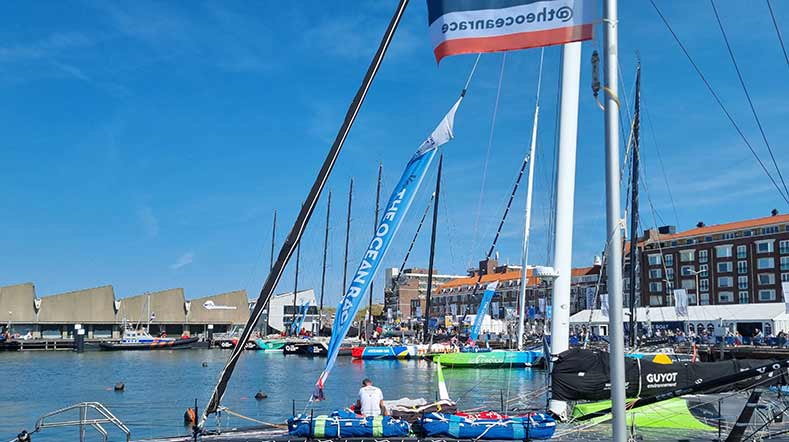
New method also considers environmental impact of microplastics
Due to the increase in the use of plastics, the formation of microplastics in the environment is rising. However, the impact of these tiny plastic particles is not yet included in environmental and sustainability analyses. TNO is changing this, using a new method. The new method calculates in a life cycle analysis how many microplastics are released during the production, use, and disposal of a specific type of plastic. Anna Schwarz, one of the lead researchers, explains how this method works and what the implications are for future environmental analyses.
Whole impact mapping
Previous research by TNO on microplastics in the Netherlands shows that a substantial reduction of microplastics is achievable if we apply various measures.
Anna Schwarz, TNO researcher explains: ‘Through our extensive research on microplastics, we already know a lot about the sources of microplastics and where they end up in the environment. However, we still know less about the environmental impact of microplastics.’
Schwarz continues: ‘At TNO, we have years of experience in life cycle assessment (LCA), such as in the CISUFLO project, to evaluate the impact of products throughout their life cycle. This experience forms the foundation for our circular scenario models. You want to include the human and environmental impact in this analysis of products. However, the environmental impacts of plastic pollution and microplastics have so far not been considered.
A plastic container enters the environment faster than a glass jar and therefore has an effect on the environment. Because that factor is currently not included, the comparison is actually not quite fair. We’ve therefore developed a new method that does include this impact of microplastics in the LCA of plastic products. This brings us one step closer to gaining a full picture of the impact of plastic products.’
A life cycle assessment, or LCA, is a sustainability calculation in which the environmental impact of a product or activity is calculated. A variety of environmental impacts are measured, such as CO2 emissions, water use, or toxicity.
An LCA is often used to compare products or services, in order to make the choice that has the least impact on the environment. You can use an LCA to answer questions such as: ‘Do you choose a glass jar or a plastic pot as a container in a specific case?’ or ‘Is it better for the environment to use a disposable plastic cup or a ceramic mug?’
New method
Schwarz says: ‘To develop our new method, we combined our own knowledge with that of the RIVM (Dutch National Institute for Public Health and the Environment) and Radboud University. With this new method, we can calculate how many microplastics are released when a plastic product is made, used, and thrown away. We include in the calculation what happens when such a product enters the environment and how many microplastics are then formed.
The method, which currently focuses on the impact of microplastics in water systems, is easy to use and also available to others who want to do calculations with it. The method could be of interest to many parties.
Manufacturers of products that replace plastics can see how their product compares to the plastic alternative if the impact of microplastics is also calculated. We can now also make a fairer comparison with biodegradable products.’

This figure includes a circle describing the life cycle of a plastic product and the stages where plastic leaks into the environment. This life cycle is assessed with a life cycle analysis.
The cycle starts at the top left where raw materials are taken from the environment to make materials. These are then manufactured and delivered to users via transport.
After use, products are collected for the end of life. For example, materials can return back in the value chain through recycling.
During the life cycle, microplastics (smaller than 5 mm) and macroplastics (larger than 5 mm) are lost to the environment. Macroplastics then degrade in the environment to form microplastics.
The impact of microplastics on the (aquatic) environment can now be mapped.
First results
‘We’ve already applied the new method a few times, for example in a study comparing the microplastics impact of two types of multilayer packaging films made from different types of polymers. It was striking that there’s a big difference in where different types of plastic polymers end up, depending on their density.
In addition, the degradation rate of plastics determines how big the microplastics impact is; the slower a polymer degrades, the longer microplastics remain in the water and the greater the environmental impact,’ says Schwarz.
Curious about the research?
Read the paper 'Microplastic Aquatic Impacts Included in Life Cycle Assessment' now.
Not only a negative impact on the LCA
‘The method may have implications for products that often end up as litter, and therefore have a substantial microplastics impact. But the method can also have positive effects. There are currently all kinds of initiatives that remove plastics from the environment and then recycle them. Such initiatives make it possible to avoid a lot of microplastics, and thus prevent the negative impact of microplastics. This impact can be counted as avoided impacts, which in turn contributes positively to LCA calculations.
Moreover, water boards, public authorities, and companies involved in litter reduction can calculate how much reduction of environmental impact and shadow costs can be achieved through their clean-up actions and the capture of plastics in the environment,’ Schwarz emphasises.
This is only the beginning
‘With this method, we’ve completed a small piece of the puzzle, as we can now include the impact of microplastics on rivers and the sea. But there’s still plenty of progress to be made. For example, we want to expand the method in the future to include the impact of microplastics on soil and human health,’ Schwarz concludes.
Work with us and become part of the solution
Want to know more about our research on life cycle assessment and microplastics? Or help us devise ways of testing the impact of microplastics on soil and humans? Then don’t hesitate to contact us. You can also ask us to perform an LCA on your product.
Get inspired
Microplastics in clothing


Microplastics and packaging: reduction is achievable


Time setters during the Ocean Race: a healthier world without microplastics


Surprisingly, in addition to packaging, car tyres and agricultural plastic biggest sources of microplastics in the Netherlands


Microplastics



